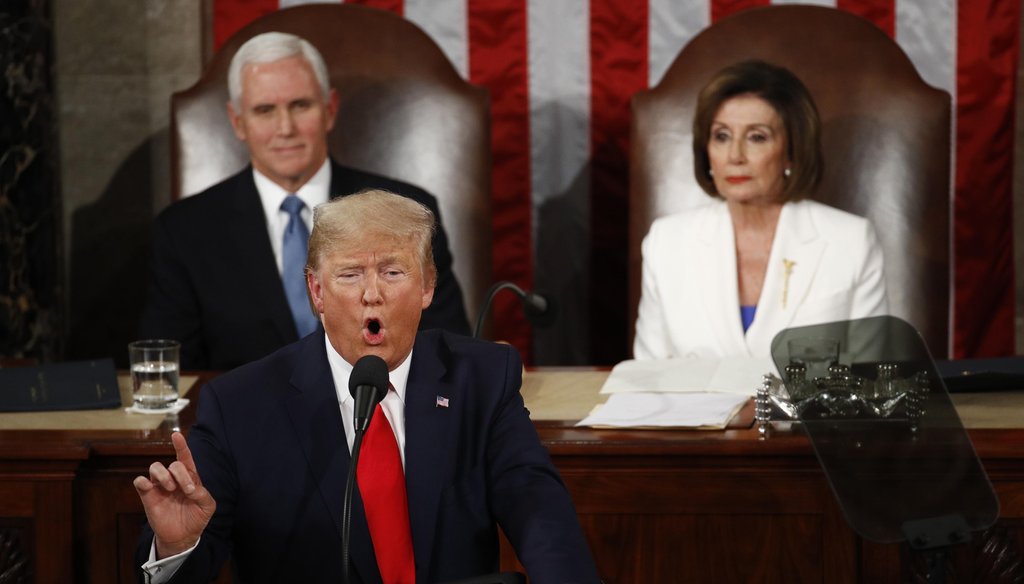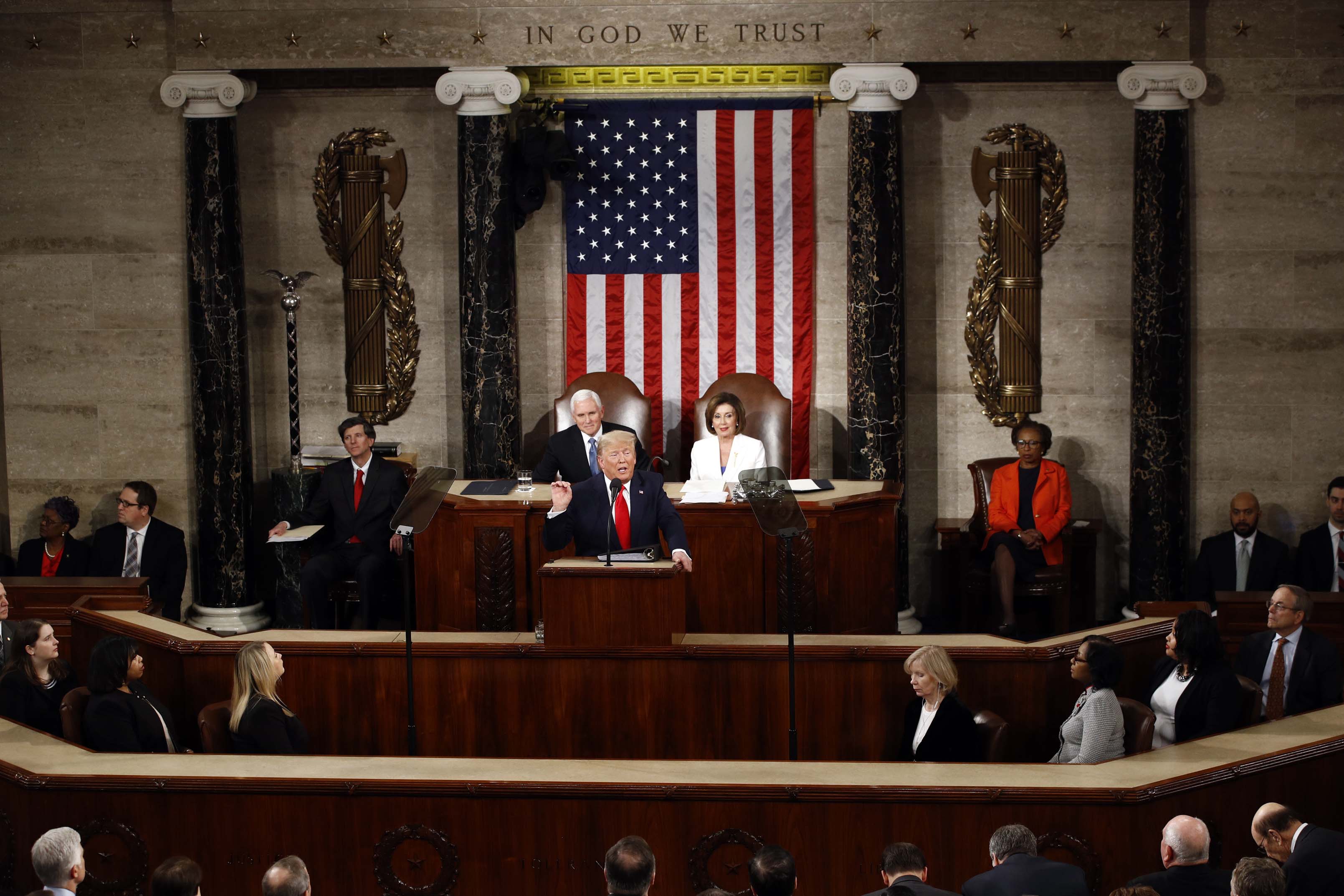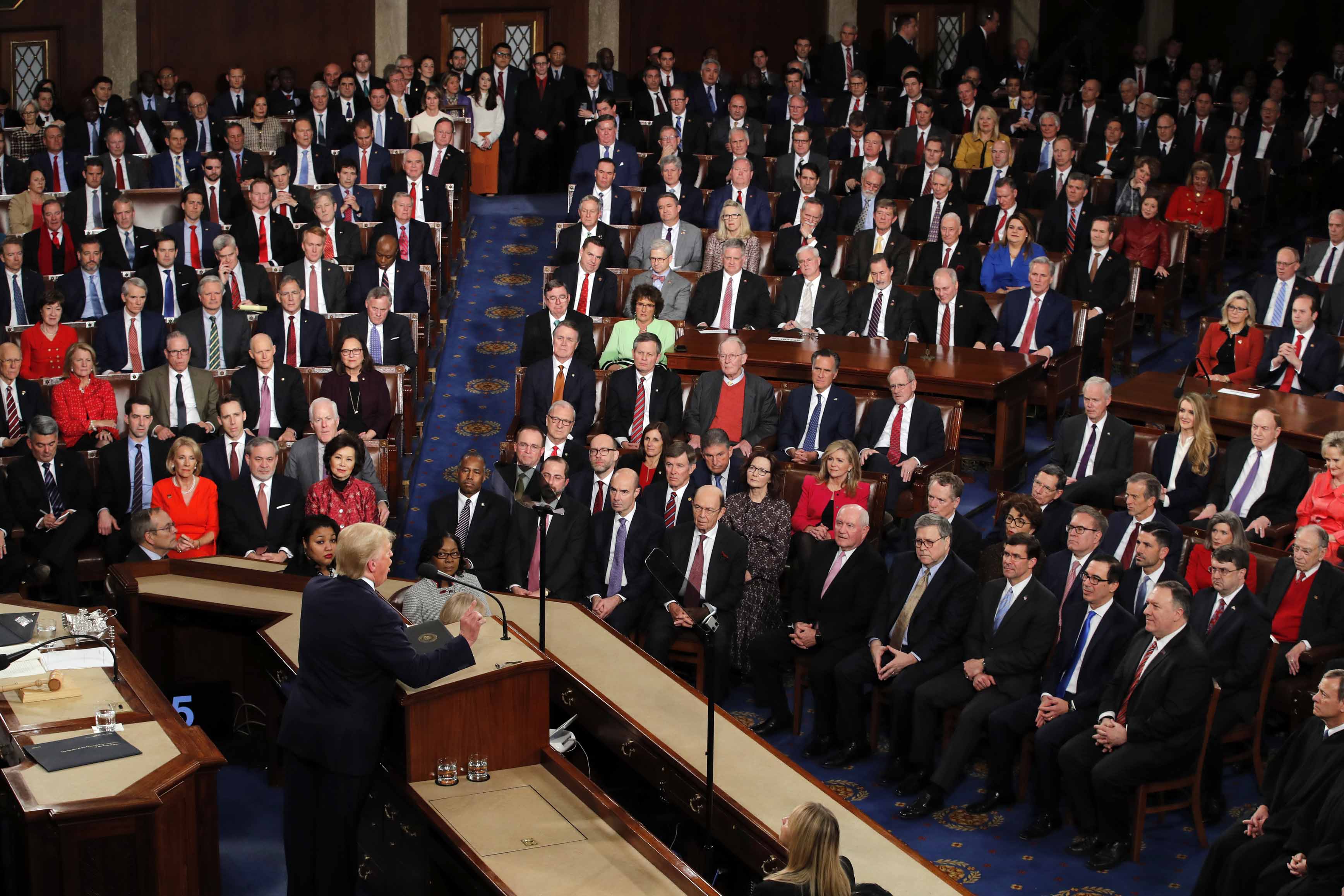Stand up for the facts!
Our only agenda is to publish the truth so you can be an informed participant in democracy.
We need your help.
I would like to contribute

President Donald Trump delivers his State of the Union address to a joint session of Congress on Capitol Hill in Washington on Feb. 4, 2020, as Vice President Mike Pence and House Speaker Nancy Pelosi, D-Calif., watch. (AP)
President Donald Trump delivered the 2020 State of the Union address in an atmosphere of intense partisanship, the day before an expected Senate vote to end impeachment, allowing Trump to stay in office and run for a second term.
Before he spoke, Trump ignored an extended hand from Democratic House Speaker Nancy Pelosi. After he spoke, Pelosi ripped up a copy of his speech. There were other cheers and jeers, with Republicans shouting "four more years!" and Democrats yelling at Trump to pass their bill on drug prices. More women lawmakers wore white, a symbol of the suffrage movement.
Trump’s speech boasted about the improved economy and included some false lines that he has repeated in campaign rallies. We fact-checked many of them for accuracy or additional context.
Health Care | Immigration | Military | Economy
NEW FACT-CHECK: Trump's State of the Union claim about welfare, food stamps is off
NEW FACT-CHECK: No, the economy didn't suddenly get strong under Donald Trump
NEW FACT-CHECK: Did Trump oversee historic funding increase for child care?
Health Care
"I've also made an ironclad pledge to American families: We will also protect patients with pre-existing conditions."
This repeated line is Pants on Fire. His administration is doing the opposite in court.
The protections for patients with pre-existing conditions come from the Affordable Care Act, which passed under then-President Barack Obama. The law says that health plans cannot charge people more for insurance because of their medical history, and is one of the ACA’s most popular provisions.
Trump has repeatedly sought and supported congressional efforts to repeal the ACA, though those efforts memorably fell flat in 2017. More recently, his administration has declined to defend the law in a pending court case, known as Texas vs. Azar. In that case, a group of Republican states’ attorneys generals is arguing that the entire law should be struck down — including the pre-existing condition protection. The case is expected to end up before the Supreme Court, though not before the 2020 election.
The administration’s stance — endorsing the lawsuit and declining to defend the law — is almost unprecedented, legal experts say.
Neither the president nor congressional Republicans has unveiled a replacement plan for the ACA. In the event the Supreme Court ultimately strikes down the health law, health plans would once again be allowed to charge people more if they have had any medical issues.
— Shefali Luthra, Kaiser Health News
"Over 130 legislators in this chamber have endorsed legislation that would bankrupt our nation by providing free taxpayer-funded health care to millions of illegal aliens, forcing taxpayers to subsidize free care for anyone in the world who unlawfully crosses our borders."
The "Medicare for All" program that many Democrats in Congress support is meant to cover undocumented people. But it is a gross exaggeration to suggest this expense would "bankrupt" the United States, especially since Medicare for All’s overall price-tag looks fairly similar to what we currently spend on health care. (It changes who pays.)
— Shefali Luthra, Kaiser Health News
"Before I took office, health insurance premiums had more than doubled in just five years. I moved quickly to provide affordable alternatives. Our new plans are up to 60% less expensive and better."
Indeed, his administration has loosened regulations on forms of coverage, such as short-term and association health plans, which are not required to comply with Affordable Care Act regulations and carry lower premiums.
It’s unclear, however, if these plans are indeed "better," as the president said. Critics point out that short-term plans, for instance, can deny people coverage based on preexisting conditions. They also say that the lower premiums are possible because the plans cover far less than an ACA plans are required to include.
— Stephanie Stapleton, Kaiser Health News
RELATED: 10 fact-checks of Rush Limbaugh, Medal of Honor winner
Last year, "for the first time in 51 years, the cost of prescription drugs actually went down."
The continued drug pricing trend suggests that prices may be stabilizing, but they are not coming down. And consumers are not experiencing that relief.
— Shefali Luthra, Kaiser Health News
"With unyielding commitment, we are curbing the opioid epidemic — drug overdose deaths declined for the first time in nearly 30 years."
The number of overdoses did fall in 2018, but it’s not clear if it’s the beginning of a trend, and the death toll remains staggering.
U.S. Centers for Disease Control and Prevention data show 67,367 drug overdose deaths in the United States in 2018, a 4.1% decline from 2017. Overdose deaths have been steadily increasing in recent decades; in 1999, the number of deaths was 16,849.
A graphic in Science magazine compiled by researchers at the University of Pittsburgh and the CDC shows that the last decline in drug overdose deaths was in 1990, but it then climbed steadily up. The mortality rate was about 2 people per 100,000 in 1990 and rose to about 17 per 100,000 by 2016.
While the overall decline in drug overdose deaths is good news, overdoses from synthetic opioids other than methadone have been on the rise.
"Fentanyl is only now spreading to the western United States, and methamphetamine addiction is resurgent, both of which could prevent the 2018 drop of overdoses from becoming a longer-term trend," said Keith Humphreys, professor of psychiatry and behavioral sciences at Stanford University.
— Amy Sherman
(AP)
Immigration
"We have now completed over 100 miles and have over 500 miles fully completed in a very short period of time. Early next year, we will have substantially more than 500 miles completed."
This needs clarification.
The 100-mile reference is mainly about the replacement of older, dilapidated barriers with new fencing. It doesn’t mean that the nearly 2,000-mile U.S.-Mexico border now has 100 more miles of barriers than it did before Trump became president.
The southwest border had 654 miles of primary barriers before Trump was elected. Three years into Trump’s term, that has increased by 1 mile, to 655 miles.
According to U.S. Customs and Border Protection, as of Jan. 24:
1 mile of barriers has been constructed where no barriers previously existed;
99 miles of barriers have been constructed to replace outdated or dilapidated designs that existed before Trump took office; and
10 miles of secondary barriers have been constructed to replace dilapidated fencing.
Customs and Border Protection said it’s identified about $11 billion from the Department of Homeland Security, Defense Department, and the Treasury Forfeiture Fund to build 576 miles worth of barriers (which includes the 110 miles already built). About half of the barriers would get new barriers to replace existing structures, and the rest would have barriers for the first time, according to the immigration agency.
— Miriam Valverde
RELATED: Nancy Pelosi's protocol snub of President Donald Trump
"As a result of our unprecedented efforts, illegal crossings are down 75% since May, dropping eight months in a row."
This accurately reflects southwest border apprehension data up to December 2019.
Border patrol apprehensions declined by about 75% from May to December. Apprehensions briefly increased by about 33% from April to May, though, so technically they have dropped seven months in a row.
Here are the numbers from Customs and Border Protection:
April: 99,273
May: 132,856
June: 94,902
July: 71,978
August: 50,684
September: 40,507
October: 35,405
November: 33,511
December: 32,858
— Miriam Valverde
Military
"Our military is completely rebuilt."
This hasn’t happened. The Trump administration has increased military spending, but rebuilding the military would require new equipment that can take years to build and develop.
Only a portion of the Trump administration’s military spending has gone toward what would be considered a rebuild under any reasonable definition of the term.
The administration’s spending has helped make troops and equipment more ready for combat, said Michael O’Hanlon, a senior fellow in foreign policy at the Brookings Institution. But overall, Trump’s claim of a total rebuild is "hyperbole."
"Most weapons are the same as before," O’Hanlon told us. "There is more continuity than change in defense policy from Obama to Trump."
— Bill McCarthy
"Soleimani was the Iranian regime's most ruthless butcher, a monster who murdered or wounded thousands of American service members in Iraq."
Soleimani, through his leadership as commander of Iran’s Quds Force, was Iran’s man in Iraq, and the militias he backed wounded or killed many American soldiers.
The last Pentagon estimate of U.S. deaths by Iranian-backed militias was 603, not thousands. The high-end estimate of total war fatalities in Iraq is about 208,000. That number includes the civilian and combatant victims from both the American-led attack in 2003 and sectarian violence by both Sunni and Shiite forces.
At Soleimani’s direction, Iran became a source of arms, funding and political guidance for Iraqi Shiite militias following the American-led invasion that toppled Iraqi President Saddam Hussein.
These militias used a range of weapons against American and Iraqi forces, including small arms, mortars, rocket-propelled grenades and roadside bombs. Improvised explosive devices, often packaged in the form of roadside bombs, were behind nearly half of all deaths.
Trump invited Kelli and Gage Hake, the widow and son of the late Army Staff Sgt. Christopher Hake, who was killed by a roadside bomb in Iraq, to the State of the Union.
— Bill McCarthy, Jon Greenberg
"Three years ago, the barbarians of ISIS held over 20,000 square miles of territory in Iraq and Syria. Today, the ISIS territorial caliphate has been 100% destroyed and the founder and leader of ISIS, the bloodthirsty killer known as al-Baghdadi, is dead."
This is accurate, but it needs some clarification. The group’s leadership predated Baghdadi, though he was instrumental in the caliphate’s rise in 2014.
In March 2019, Syrian Democratic Forces captured the Syrian village of Baghouz, officially ending the Islamic State’s territorial claims.
According to a June 2017 analysis from consulting firm IHS Markit, ISIS held about 23,320 square miles of territory as of January 2017. That was down more than 11,000 square miles from two years earlier under President Barack Obama.
In October 2019, Abu Bakr al-Baghdadi, an ISIS commander, was killed during a U.S. military operation in Syria. Jordanian jihadist Abu Musab al-Zarqawi was the founder of several ISIS predecessor groups dating back to 1999, including al-Qaida in Iraq, which was formed in 2004.
In June 2006, Zarqawi was killed in a U.S. airstrike. Abu Bakr al-Baghdadi became the leader of ISIS in April 2010. ISIS rebranded itself as the Islamic State on June 29, 2014, when Baghdadi announced the formation of the caliphate.
ISIS remains a threat, even without its caliphate. The New York Times has reported that as many as 18,000 fighters remain in Iraq and Syria and there have been several attacks around the world since the group’s territorial defeat.
— Daniel Funke
(AP)
Economy
"After decades of flat and falling incomes, wages are rising fast — and, wonderfully, they are rising fastest for low-income workers, who have seen a 16% pay increase since my election. This is a blue collar boom."
This is Half True. Looking at the change in weekly earnings since 2016, the bottom 10% saw a 14.6% rise, compared with 13.5% for the top earners. But looking at the change from year to year, in 2017 and 2019, earnings for the top 10% grew faster than for the lowest wage earners. Trump’s statement was true for one out of his three years in office.
But there are two key problems with using weekly earnings to compare the lowest to the highest groups. The government’s survey excludes the self-employed, and at the high end, that means lawyers, engineers, and other well-paid positions. Their income doesn’t show up. In addition, the survey doesn’t doesn’t count earnings over $150,000. Someone making $250,000 would be entered as earning $149,999. That makes the high-end number in the data artificially low.
— Jon Greenberg
Says he enacted "historic and record-setting tax cuts."
False. In inflation-adjusted dollars, the recent tax bill is the fourth-largest since 1940. And as a percentage of GDP, it ranks seventh.
— Louis Jacobson
"Since my election, we have created 7 million new jobs."
This is accurate, though he breaks the 7 million barrier by counting two months of Obama’s presidency. During his own presidency, the number of non-farm jobs rose from almost 146 million in January 2017 to a little over 152 million in December 2019, which is an increase of almost 6.7 million directly on Trump’s watch.
No president deserves all the credit for job gains, or all the blame for job losses. Such factors as business patterns, technological change, and the international economic climate can play major roles as well.
— Louis Jacobson
"The unemployment rates for African Americans, Hispanic Americans, and Asian Americans have reached the lowest levels in history."
This is accurate for unemployment as long as you look at the lowest rate achieved on Trump’s watch, rather than specifically at the most recent month’s figures.
African American unemployment, which has been recorded since 1972, hit its historical low at 5.4% in August 2019. It’s now slightly higher — 5.9%.
Hispanic unemployment, which has been recorded since 1973, reached its historical low of 4.1% in October 2019. It has since risen slightly to 4.2%.
And Asian American unemployment, which has been recorded since 2000, reached its all-time low of 2.0% in May 2018. It is now a bit higher at 2.4%.
Economists urge not overemphasizing small monthly shifts in the unemployment rate for groups like these, because the margin of error is bigger for smaller groups than for the country as a whole. It’s also worth noting that the decline in unemployment rates for these groups began well before Trump took office, under Obama.
— Louis Jacobson
"African American poverty has declined to the lowest rate ever recorded."
That’s correct. The African American poverty rate was 20.8 percent in 2018 — an all-time low since data was first kept consistently in 1966.
— Louis Jacobson
"America has now gained 12,000 new factories under my Administration."
This leaves out some important context. The number of manufacturing jobs for production and nonsupervisory workers fell by 12,000 last year. It is one thing to see the number of plants and mills grow, but that doesn’t automatically mean that the number of jobs will also increase.
Also, the growing number of manufacturing facilities has been underway for many years.
The upswing started in 2013 and has continued at a steady clip ever since. The pace accelerated a bit under Trump, but the trend started four years before he took office.
— Jon Greenberg
"In eight years under the last administration, over 300,000 working-age people dropped out of the workforce. In just three years of my administration, 3.5 million working-age people have joined the workforce."
Trump has the general trend right, but he leaves out some context. Obama took office during the Great Recession. Once the worst of the recession had passed, it started climbing, at roughly the same pace as it has under Trump, as the following chart shows.
Looking at the number of Americans in the civilian labor force, the number fell under Obama by more than Trump said, declining by 1.5 million. It rose by a smaller amount under Trump than he said — 2.46 million.
— Louis Jacobson
"Thanks to our bold regulatory reduction campaign, the United States has become the No. 1 producer of oil and gas anywhere in the world, by far."
The United States is the world’s top producer of oil and natural gas. But Trump is taking too much credit. This not a new feat.
The United States has been the world’s largest oil producer since 2012 and the top natural gas producer for years. Both achievements happened before Trump took over the White House, but that hasn’t stopped Trump and his allies from giving him the credit.
— Bill McCarthy
"The unemployment rate for women reached the lowest level in almost 70 years."
This is accurate. The current unemployment rate for women is 3.5%. The last time it was lower than that — 3.4% — was in September 1953, which was more than 66 years ago. The women’s unemployment rate began falling under Obama, not only under Trump.
— Louis Jacobson
"Real median household income is now at the highest level ever recorded."
This is accurate. After two consecutive annual increases under Obama, inflation-adjusted median household income has risen twice under Trump. The most recent data shows the figure at $63,179 in 2018. Here’s a chart showing median household income under recent presidents, with Democrats in blue and Republicans in red.
— Louis Jacobson
"Workers without a high school diploma have achieved the lowest unemployment rate recorded in United States history."
That’s accurate, at least since that statistic was first calculated in 1992. The unemployment rate in December 2019 was 5.2%, slightly higher than the all-time low of 4.8% set earlier in Trump’s presidency in September 2019.
— Louis Jacobson
RELATED: In State of the Union rebuttal, Texas rep. exaggerates debt attack on Trump
Our Sources
See fact-checks.









































